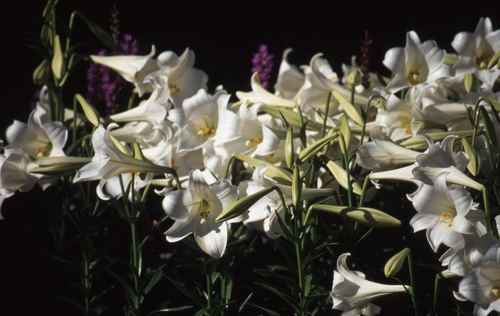
Did you know that lilies are made from milk? Well, not quite, but Roman legend has it that while Juno, queen of the gods, was feeding her son Hercules, some of her milk fell from the mythical heavens and these drops formed beautiful white li-lies. Believe what you want, but there definitely is something magical about this plant – especially the pure white species of Lilium longiflorum. Known commonly as the St. Joseph’s lily, it’s associated with Joseph of Nazareth, the husband of Mary the mother of Jesus, as he is generally depicted with a staff blooming with these exquisite petals. Also known as the Easter lily, L. longiflorum is often found decorating church altars during Easter ceremonies because of its symbolism of purity and new life.
And to think that these flowers nearly never made it beyond Japan.
Native to the Ryukyu Islands of southern Japan, L. longiflorum began its commercial production in Bermuda in the mid 1800s but this business was destroyed later that century by a virus infestation. So Japan took over this production and exportation of the lily to America, making a name for itself as the US’s biggest importer of these blooms. However, when World War II began in 1939, Japanese imports were quickly halted, and the cost of St. Joseph’s lilies immediately increased. Clever entrepreneurial Americans hastily began their own production and made big bucks on these St. Joseph’s lily bulbs, which became known as ‘white gold’ due to their great value.
They may be more affordable nowadays, but L. longiflorum is no less in demand. Its trumpet-shaped petals are filled with an intoxicating scent that injects a room with sweetness, and its long stems (up to a metre high) mean that St. Joseph’s li-lies really can fill up an interior space without much effort.
Plant these bulbs in full sun to semi-shade between May and August and you could have flowers from September through to January, making the spring and summer months in your garden ultra special as bursts of white appear. Make holes 8cm deep and 15cm apart for each bulb, in soil that is carefully considered to be cool, with a good percentage of humus and good drainage. If necessary, start off the process by digging a deep hole in the area you wish to plant and mixing sand and compost (and even well-decomposed manure if ne-cessary) into the soil. End off the planting process by wate-ring the ground and adding a top layer of mulch to keep it all cool and moist, and to protect the bulbs from frost in very cold areas.
During summer, when your St. Joseph’s lilies are growing at their fastest rate, feed the soil with fertiliser and insert stakes in the ground (being careful not to stake the bulbs themselves!) to support the stems. At the end of the flowering season, and once the stems have yellowed and been cut off and discarded, you may leave the bulbs in position in the ground, as L. longiflorum thrive when left in the same spot for five years, on condition that they receive adequate nutrition.
Nutrition being a key factor, it’s also important to bear in mind that when cutting your white blooms to place in vases, you should cut the stems 30cm above the ground in order to retain some leaves for photosynthesis to continue. You provide the water every four days for 40 minutes at a time, and the sun will take care of the rest.
Come see our Facebook page, http://www.facebook.com/hadeco.bulbs, follow us on Twitter @HadecoBulbs, come shop with us at our Online Shop www.hadeco.co.za/shop or visit www.hadeco.co.za for more information.
Gansbaai Courant provides the Gansbaai community with the latest in news and interesting stories about and around the area.
View Profile
What is Xplorio?
Xplorio is your local connection allowing you to find anything and everything about a town.
Read More












